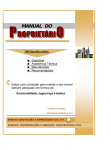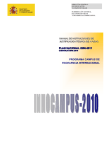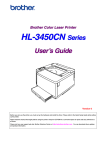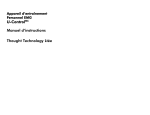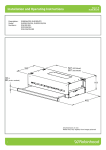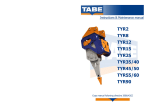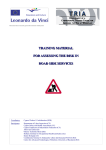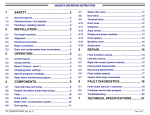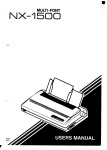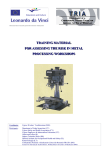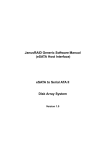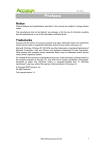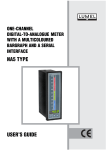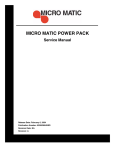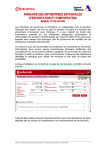Download hennig chip disc filtration system manual 1-15-09
Transcript
Chip Disc Filtration System Service Manual Hennig, Inc. 9900 N. Alpine Road Machesney Park, Il 61115 (815)636-9900 (Ph.) (815)636-9737 (Fax) E-Mail: [email protected] Manual Revision Date: 1/15/09 HENNIG CHIP DISC FILTRATION SYSTEM -1- The Hennig Chip Disc Filtration System, or CDF System, is available in a variety of configurations to be adaptable to a wide array of machine tool applications. The CDF System is designed to remove chips and debris from coolant used in machine tool applications. The life of the CDF System can be extended greatly by following the instructions and guidelines in this manual. For assistance in new applications or questions regarding your system, please contact a Customer Service Representative at our U.S. manufacturing facility: Hennig, Inc. 9900 N. Alpine Road Machesney Park, Il 61115 (815) 636-9900 (815) 636-9737 (fax) Index Introduction to Hennig CDF System ……………………………………………… Page 2 Ordering Instructions for Parts ……………………………………………………. Page 2 Installation and Start-up Instructions ……………………………………………… Page 3 Scheduled Maintenance Procedures …………...………………………………..… Page 4 Belt Removal, Maintenance, & Installation Procedure …………………………… Page 5 & 6 Parts List and Drawings ………………………………………………………….... Page 7 - 13 IIM MPPO OR RTTA AN NTT IIN NSSTTR RU UC CTTIIO ON NSS F FO OR R O OR RD DE ER RIIN NG G PPA AR RTTSS It is important to have the following information available when ordering parts: • Hennig CDF System Model Number* • Hennig Serial Number* • Part Name & Number (per parts list) • Manual Revision Date (found on page 1) (*) - May be found on the name plate located on the side of the head section of the conveyor. -2- INSTALLATION AND START-UP INSTRUCTIONS Your new Hennig CDF System has been tested and inspected prior to delivery to ensure its proper function upon installation. Please follow these instructions for start-up of your system: 1. Visually inspect your system for any shipping damage. Contact Hennig, Inc. immediately if damage has occurred. 2. Roll entire system (filter/conveyor and tank) into position so that the filter/conveyor chip chute is located under the machine coolant/chip discharge. 3. Level coolant tank using leveling screws mounted on the sides. After the tank is level, adjust the support feet or casters (if supplied) of the filter/conveyor for sufficient support. Tighten locknuts. 4. Install power and auxiliary control cables into electrical box or switch. Be sure to use the correct voltage and phase for the system. Proper rotation of the filter/conveyor belt & pumps may be obtained by reversing power connection. It is very important that all motors rotate in the proper direction. 5. Make sure all foreign objects such as shipping papers, crating, cleaning rags, etc. are removed from the filter/conveyor prior to start-up. 6. Check the belt tension of the conveyor. Adjust tension using tension bolts and lock in place using jam nuts if required. 7. Install Disc(s) if shipped loose – Very important - Be sure to grease “v-seal” and/or “wearplate” surface with standard bearing/axel grease. Slide “disk ass’y” onto disc “shaft,” install “clamp nut” and tighten until “v-seal” is compressed to overall height 12.5/13.5 mm. Tighten “lock screw” on “clamp nut.” (Figure #3A, #3B, & #3C) 8. Fill the coolant tank to the level indicated on the CDF System layout drawing. Typically the coolant level can be maintained approximately 2” below the covers of the tank. Check for any leakage and contact Hennig, Inc. if any occurs. If an integral super-clean tank is supplied, be sure to fill it with coolant also. Warning: Never fill a tank with the pumps running (tank may overflow when coolant returns from machine due to over filling). 9. Install all required plumbing to pumps, chillers, bag filters, etc. Ensure that all fittings are correctly tightened before starting pumps. Check for leaking fittings and tighten accordingly. 10. Install wiring for pumps, chillers, oil skimmers, hi/low float switches, etc. to machine electrical system if required. Ensure that all electrical service meets local codes. 11. Make sure hands, feet, and clothing are clear of all moving parts before start-up. 12. Make sure all drive train guarding is in place and securely attached before start-up. 13. Locate a chip hopper under the filter/conveyor discharge for collection of chips. 14. Start-up machine and Hennig CDF System. 15. Set filter backwash flow rate using valve as shown in chart (Figure #1). Note: The filter conveyor should be set up to run continuously while machine tool is discharging coolant and chips. Unusually high amounts of chips during a short period of time can result in jamming the filter/conveyor. C CA AU UT TIIO ON N:: K KE EE EPP H HA AN ND DSS,, F FE EE ETT,, A AN ND DC CLLO OTTH HIIN NG GC CLLE EA AR R O OF FM MO OV VIIN NG G PPA AR RTTSS O OF FF FIILLTTE ER R//C CO ON NV VE EYYO OR R -3- SCHEDULED MAINTENANCE PROCEDURES Daily Maintenance: 1. Check coolant level in tank. Fill if necessary. Never fill tank with pumps in operation – overflow may occur due to overfilling once pumps are shut off. 2. Check filter “backwash system” for sufficient spray. Check “Y – Strainer” for chips and clean out as required. (Figure #1) 3. Insert 1-3 shop rags down under the discharge of hinge belt filters/conveyors and allow them to run through the conveyor in an effort to clean out any chips. Repeat if necessary. Caution: Do not stick hands into harms way of conveyor belt – avoid pinch points. 4. Check the coolant discharge level of the “disc.” If the coolant level in the conveyor is higher than normal, check the “filter screen” for abnormal blockage. If the “backwash system” is operating properly, consideration should be given to steam cleaning or replacing the “filter screen.” 1000 Hour Maintenance: 1. Check tension of filter/conveyor “hinge/scraper belt” by checking the torque setting of the “adjusting screws” for the “take-up bearings” on each side of the head (Figure 4D). Torque to be set at 25 in-lbs. Note: If the “hinge/scraper belt” tension is adjusted please check the “motor drive chain” tension as it may have changed. (Figure #4C) Adjust “chain guard” as required (Figure #4A). 2. The “torque limiter” (or clutch) is set at the factory. The torque setting can vary between individual systems but typically ranges between 20 – 60 ft-lbs. Do not over-tighten the “torque limiter” as damage may occur to the filter/conveyor in the event of a jam. (Figure #4C) 3. Check the tension and alignment of the “motor drive chain.” There should be approximately ½” of slack (side to side) on the chain. The chain should also be lightly oiled at this time, taking care not to introduce oil to the “torque limiter friction pads.” (Figure #4C) 4. Grease “take-up bearings” with grease gun. Do not over grease – seals can be damaged. (Figure #4B & #4D) 5. Inspect “hinge/scraper belt” for wear or damage. (See Hinge/Scraper Belt Removal and Installation Procedure if necessary) 6. Remove “disc assembly” and check seal and screen for damage. Replace or clean if necessary. Upon re-installation, be sure to tighten “clampnut” until “v-seal” is compressed to overall height of 12.5-13.5 mm. Lock “clampnut” in place by tightening “lock screw.” (Figure #3A, #3B, & #3C) 7. Check “backwash system” for sufficient flow and pressure. Clean out any chips found in “Y – Strainer” or “spray nozzles.” (Figure #1 & #3A) 8. Check “disc drive bearings” and lubricate with grease. Check “wear plate” for wear – replace as necessary. (Figure #3A) 9. Maintain pumps, chillers, oil skimmers, etc. per manufacturer’s service manual. 10. For “Cast Iron Filter” option, check “scraper blade” for wear and adjust as necessary. Also, check “idler chain” and “drum drive chain” for slack. Adjust tension with “adjusting screws” grease “pillow block bearings” & “magnetic drum bearings” with grease gun. (Figure #8B) -4- BELT REMOVAL, MAINTENANCE, AND INSTALLATION Hennig CDF Systems are typically equipped with either a “hinge belt” or “scraper belt” dependant upon the specific application. The “scraper belt” is wide open for viewing of critical components so maintenance requirements are easily seen. On the other hand, inspection of the “hinge belt” can be slightly more involved. General inspection of either belt type can be accomplished at the discharge opening at the head of the filter/conveyor, by removal of the slide lid, or through openings in the trough (Figure #2). Detailed inspection of a “hinge belt,” however, requires complete removal of the belt from the filter/conveyor body to provide complete access to all the integrated components. “Hinge Belt” Removal: 1. Disconnect power source to filter/conveyor. 2. Drain tank or remove filter/conveyor from tank as required. 3. Run filter/conveyor until the “master shaft” (identified as shaft with cotter pins and washers) are positioned at the slot opening located near the discharge of the conveyor (so that the “master shaft” may be knocked out – Figure #6). Note: if the filter/conveyor is jammed and cannot be run, go to step #4. 4. Remove “flip lid,” “bearing cover,” “outside chain guard,” and “slot guards” (found at discharge end of conveyor – Figure #2). 5. Remove “drive chain” from the “gear motor” by reducing tension and removing “chain master link.” (Figure #5) For optional direct drive motor mounting, remove motor mounting screws and nuts and pull motor off drive shaft. (Figure #4A) 6. Turn “take-up bearing screws” counter-clockwise to reduce tension of “hinge belt.” Be sure to note the position of the bearings prior to reducing tension so the correct tension may be easily set upon re-installation. (Figure #4D) 7. Remove “cotter pin” and “washer” from “master shaft.” Slide the “master shaft” out of the belt assembly. If the “master shaft” cannot be moved into removal position (as stated in step #3), any “shaft” located in the slot near the discharge of the filter/conveyor may be removed by, first, grinding the crimp from the end of the “shaft” to allow for removal (a new “master shaft” may be obtained from Hennig, Inc.). (Figure #5) 8. At this point, the belt should easily be disconnected. Re-install the “master shaft” into the belt in the top section only to aid in belt removal. 9. Remove “disc cover” and loosen the “clampnut” & “lock screw” enough to relieve the friction of the “seal” with the “wear plate.” (Figure #3A & #3B) 10. Remove the belt assembly from the filter/conveyor by pulling out the bottom end of the belt assembly first (the “master shaft” should trail the belt assembly as it comes out). (Figure #7) C CA AU UT TIIO ON N:: A ALLW WA AYYSS D DIISSC CO ON NN NE EC CTT PPO OW WE ER RB BE EF FO OR RE E PPE R F O R M I N G A N Y M A I N T E N A N C E ERFORMING ANY MAINTENANCE -5- “Hinge Belt” Maintenance: 1. Clean belt – remove excessive build up of chips and swarf. 2. Visually inspect belt for damage and wear. a. Ensure that rollers are rotating freely and check for wear. (Figure #5) b. Check belt shafts for wear. (Figure #5) c. Ensure that stainless steel scrapers &/or polyurethane wipers (mounted to cleats on hinge belt) are not worn or damaged – replace if necessary. d. Check “hinge plates” for damage. (Figure #5) 3. Check guide rails, sprockets, rail knobs, and conveyor body for wear or damage. (Figure #7) C CA AU UT TIIO ON N:: A ALLW WA AYYSS W WE EA AR R PPR RO OTTE EC CTTIIV VE EG GLLO OV VE ESS W WH HE EN N H HA AN ND DLLIIN NG GA AH HIIN NG GE EB BE ELLTT “Hinge Belt” Installation: 1. With “master shaft” installed as stated in the “Hinge Belt Removal” procedure (step #8), feed the belt in (master shaft first) on lower rail system until the ends of the belt meet back up at the discharge of the filter/conveyor. (Figure #7) 2. Remove the “master shaft” and mesh the two knuckles of the mating hinge plates together. Slide the master shaft through the mating parts of the belt assembly (install “washers” and “cotter pin” on each end). (Figure #5) 3. Adjust the belt tension by checking the torque setting of the “adjusting screws” for the “takeup bearings” on each side of the head. Torque to be set at 25 in-lbs or adjust “take-up bearings” to original position. (Figure #4D) 4. For overhead drives, install “motor drive chain” and tension until there is ½” of play side to side (Figure #4C). For direct drive motor option, install gearmotor by sliding over shaft and key, and replace motor mounting screws and nuts. (Figure #9) 5. Tighten “clampnut” until filter disc seal is compressed to overall height of 12.5 to 13.5 mm overall height. Lock “clampnut” in place with “lock screw” and replace “disc cover.” (Figure #3A & #3B) 6. Replace all guards and covers. 7. Re-install filter/conveyor into tank and add coolant as required. 8. Connect power source. SSP PA AR RE EB BE EL LT TP PA AR RT TSS A AN ND D C CO OM MP PL LE ET TE EB BE EL LT TA ASSSSE EM MB BL LIIE ESS C CA AN N B BE EP PU UR RC CH HA ASSE ED DA AT TH HE EN NN NIIG G,, IIN NC C.. -6- PARTS LISTS HOSE (1-1) VALVE (1-2) BACKWASH PUMP (1-4) FIGURE #1 Y-STRAINER (1-3) SLIDE LID (2-1) FLIP LID (2-4) FILTER HOUSING COVER (2-6) HEAD (2-5) TROUGH (2-3) FILTER ASS’Y (2-2) FIGURE #2 -7- SCREW (3-1) V-SEAL (3-14) (12.5/13.5 mm COMPRESSION) Bearing/Axel Grease FILTER SPROCKET (3-15) DISC COVER (3-2) BEARING COVER (3-7) NOZZLE (3-5) MANIFOLD (3-4) BEARING SEAT (3-16) BEARING (3-9) DISC CASTING (3-13) SHAFT (3-12) FIGURE #3A SCREW (3-3) CLAMPNUT & LOCK SCREW (3-6) SCREEN (3-10) SCREEN CLAMP (3-11) WEARPLATE (3-15) FIGURE #3B -8- SCREEN (3-10) DISC CASTING (3-13) SCREEN CLAMP (3-11) V-SEAL (3-14) FIGURE #3C (DISK ASS’Y) DRIVE MOTOR DIRECT DRIVE (4-9) CHAIN GUARD (4-8) FIGURE #4A (DIRECT DRIVE – FLIP LID NOT SHOWN) -9- MOTOR BRACKET (4-8) TAKE-UP BEARING (4-6) BEARING COVER (4-5) DRIVE SHAFT (4-2) BELT SPROCKET (4-1) FIGURE #4B (DIRECT DRIVE SECTION) DRIVE MOTOR IN LINE (4-11) CHAIN GUARD (4-10) COVER (4-15) NOT SHOWN DRIVEN SPROCKET (4-3) MOTOR ADJUSTING SCREW & NUT (4-14) TORQUE LIMITER (4-4) FIGURE #4C (OVERHEAD DRIVE W/ TORQUE LIMITER) - 10 - DRIVE SPROCKET (4-7) BEARING BRACKET (4-12) TAKE-UP BEARING (4-6) JAM NUT (4-13) ADJUSTING SCREW (4-9) FIGURE #4D (BEARING COVER REMOVED) CLEAT (5-1) HINGE PLATE (5-2) SIDEWING (5-3) SHAFT (5-4) CHAIN SIDE LINK (5-5) CHAIN ROLLER LINK (5-6) WASHER (5-7) COTTER PIN (5-8) MASTER SHAFT (5-9) FIGURE #5 (HINGE BELT ASS’Y.) - 11 - BELT MASTER SHAFT REMOVAL THRU THIS SLOT (REMOVE PLATE) FIGURE #6 (HINGE BELT FILTER HEAD) UPPER GUIDE RAIL (7-2) BELT INSTALLATION: FEED BELT INTO CONVEYOR ON LOWER RAILS (REVERSE DIRECTION FOR BELT REMOVAL) RAIL KNOB (7-3) LOWER GUIDE RAIL (7-1) FIGURE #7 - 12 - CAST IRON FILTER HOUSING (7-1) FIGURE #8A (CAST IRON OPTION) ADJUSTING SCREW & NUT (7-11) DRUM DRIVE CHAIN (7-6) MAGNETIC DRUM (BEARINGS NOT SHOWN) (7-3) DRUM DRIVE SPROCKET (7-4) ADJUSTABLE SCRAPER BLADE (7-12) DRUM DRIVE SHAFT (7-5) SCRAPER BLADE BRACKET (7-13) BEARING (7-7) IDLER SHAFT (7-8) FILTER DRIVE SPROCKET (7-2) IDLER SPROCKET (7-9) IDLER CHAIN (7-10) FIGURE #7B (CAST IRON OPTION) - 13 -













